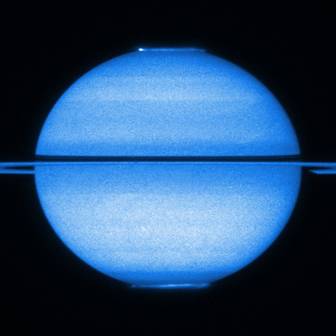Astronomy news
Hubble captures stunning images of double
aurora on Saturn
12 February 2010
Stunning new images taken by the Hubble space telescope have given a
once in a lifetime view of the fluttering aurorae that light up both of
Saturn's poles.
It takes Saturn almost thirty years to orbit the Sun, with the
opportunity to image both of its poles occurring only twice in that
period. Hubble has been taking pictures of the planet at different
angles since the beginning of the mission in 1990, but 2009 brought a
unique chance for Hubble to image Saturn with the rings edge-on and both
poles in view. At the same time Saturn was approaching its equinox [1]
so both poles were equally illuminated by the Sun's rays.

Double light show in a single shot: Hubble images
both of Saturn's aurorae.
Credit: NASA, ESA and Jonathan Nichols (University of Leicester)
The study is a result of two Hubble Space Telescope programmes led by
Dr Jonathan Nichols at the University of Leicester. Dr Nichols said:
"Hubble has proved to be one of mankind's most important scientific
tools, and this is the first time that a group in the UK has led a HST
programme to observe the aurorae on another world.
"However, scientists at the University of Leicester, including Prof.
Stan Cowley and Dr. Emma Bunce in the Radio & Space Plasma Physics
Group, did not just observe using HST, they are also actively involved
in the Cassini mission which is observing many different aspects of
Saturn's aurorae and magnetic field, and which was recently extended to
2017 by NASA. The HST and Cassini observations combine to form a
significant scientific force.
"It is particularly exciting to know that these images are unique to
science. They have not, and will never again, be obtained using Hubble.
This is because HST pictured Saturn at a very special vantage point,
near its equatorial plane. Due to Saturn's long orbit, HST will not see
this view again in its lifetime.
"This sustained series images of
simultaneous north-south aurorae are important scientifically, since
they cannot be obtained at any other planet, including Earth. They tell
us a great deal about the nature of the planet's magnetic field and the
processes which generate aurorae in a way not possible at Earth. It's a
great example of how planetary science can fully complement the study of
the Earth."
These recent observations go well beyond just a still image and have
allowed researchers to monitor the behaviour of both Saturn's poles in
the same shot over a sustained period of time. The movie they created
from the data, collected over several days during January and March
2009, has aided astronomers studying both Saturn's northern and southern
aurorae.
Despite its remoteness, the Sun's influence is still felt by Saturn.
The Sun constantly emits particles that reach all the planets of the
Solar System as the solar wind. When this electrically charged stream
gets close to a planet with a magnetic field, like Saturn or the Earth,
the field traps the particles, bouncing them back and forth between its
two poles.
A natural consequence of the shape of the planet's magnetic field, a
series of invisible "traffic lanes" exist between the two poles along
which the electrically charged particles are confined as they oscillate
between the poles. The magnetic field is stronger at the poles and the
particles tend to concentrate there, where they interact with atoms in
the upper layers of the atmosphere, creating aurorae, the familiar glow
that the inhabitants of the Earth’s polar regions know as the northern
and southern lights.
At first glance the light show of Saturn's aurorae appears symmetric
at the two poles. However, analysing the new data in greater detail,
astronomers have discovered some subtle differences between the northern
and southern aurorae, which reveal important information about Saturn's
magnetic field.
The northern auroral oval is slightly smaller and more intense than
the southern one, implying that Saturn's magnetic field is not equally
distributed across the planet; it is slightly uneven and stronger in the
north than the south. As a result, the electrically charged particles in
the north are accelerated to higher energies as they are fired toward
the atmosphere than those in the south. This confirms a previous result
obtained by the space probe Cassini, in orbit around the ringed planet
since 2004.
Footnote
1. The equinox identifies one of the two moments during a planet's
journey around the Sun when the light rays coming from the star are
perpendicular to the planet's equator. On Earth, we are familiar with
the spring and autumn equinoxes, two special dates in the calendar when
day and night have the same length everywhere on the globe. Just like
equinoxes on Earth, which occur twice in a yearly orbit, Saturn also has
two equinoxes per orbit. However, Saturn takes almost 30 Earth years to
orbit the Sun, thus experiencing an equinox every 15 of our years.
To top |